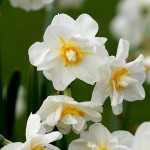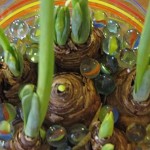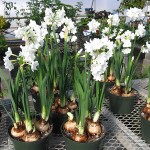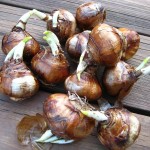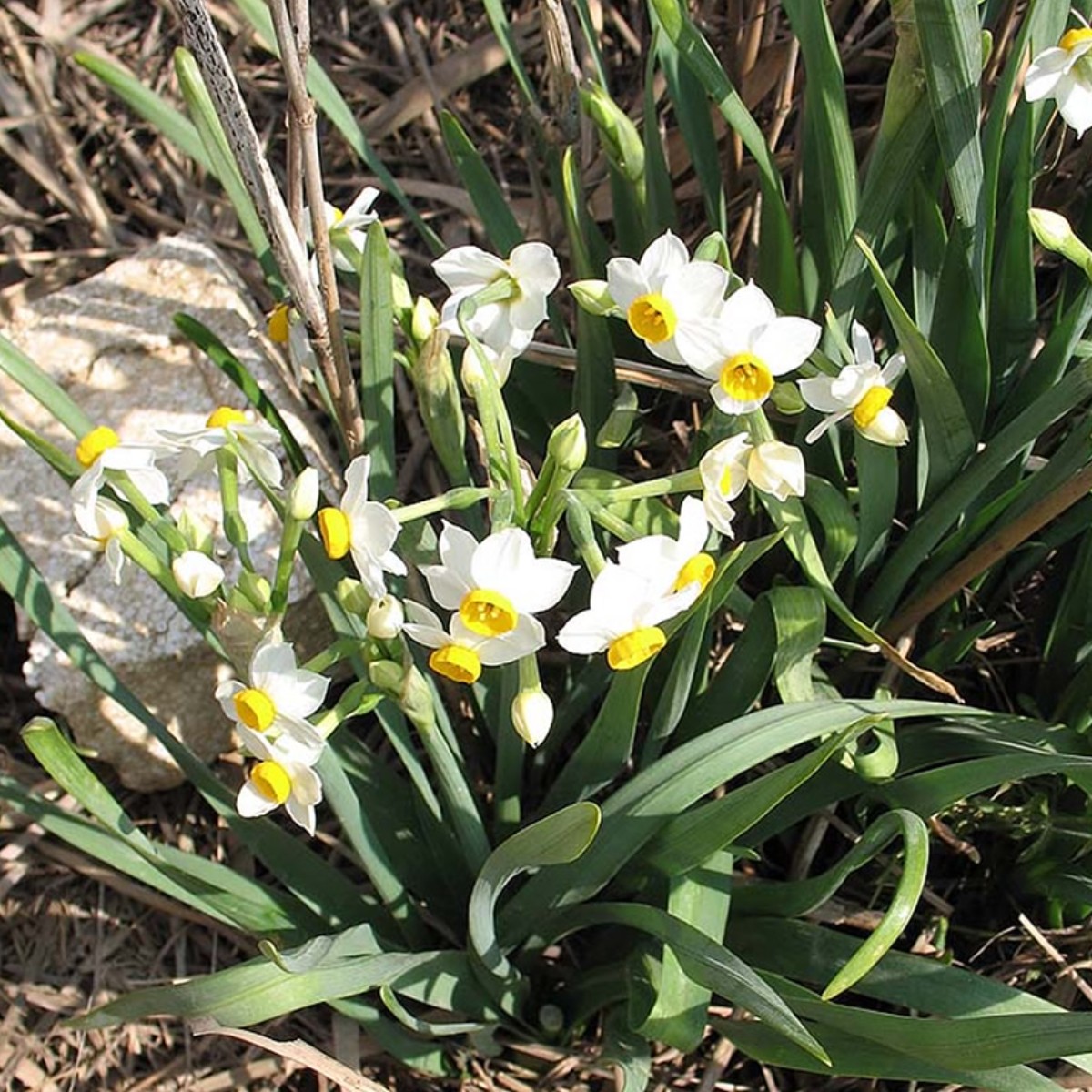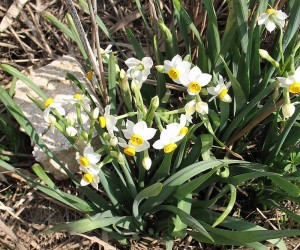Family: Amaryllidaceae
Subfamily: Amaryllidoideae
Synonymous: Narcissus linnaeanus
Narcissus canaliculatus
Distribution and habitat: Narcissus tazetta is a widespread species, native to the Mediterranean region from Portugal to Turkey and across the Middle East and Central Asia to Bhutan, as well as from the Canary Islands, China and Japan. It is also naturalized in Australia, Bhutan, Korea, Norfolk Island, New Zealand, Bermuda, Mexico and the United States.
In wild Narcissus tazetta natural habitat are garigue (especially if with considerable amount of soil) uncultivated fields and valleys.
Description: Narcissus tazetta are bulbous perenial plants grown for their fresh coloured graceful scented flowers. This plant has thin, flat leaves up to 40cm (16 inch) long and 15mm (0.6 inch) wide.
Narcissus tazetta are bunch flowered (polyanthus) types of Narcissus and are most suitable species of this genus for use as indoor plants. Umbels have as many as 8 flowers, white with a yellow corona. The flowers have a cup (trumpet) shaped corona that are sometimes very much reduced in size and are backed by 6 petals.
Plants care: Indoors Narcissus tazetta bulbs can be forced to flower in winter. Potted plants can be enjoyed while coming into flower and during the brief flowering period, but they must be discarded when the flowers have faded. The bulbs will not flower twice indoors.
It is possible to buy Narcissus tazetta that have been subjected to a special cooling treatment that makes them flower earlier than than untreated bulbs. These treated Narcissus tazetta bulbs (always clearly labelled as such) may be started into growth either in the light or in the dark. The disadvantage of untreated bulbs is that they must be started in the dark. The best time for planting is early autumn and a cool temperature for the first few weeks is essential.
Do not subject budding Narcissus tazetta to room temperatures above about 15C (59F). Heat will cause flower buds to shrivel. It will also shorten the life of any that do develop.
Planting on pebbles: Use a water-proof container at lest 10-13cm (4-5 inch) deep and cover the bottom with pebbles. Place 5 or 6 'double-nosed' bulbs (those partially divided into two flowering-size sections, but remaining attached to each other) or 8 to 10 fair-sized single buds on top of the pebbles. Stand the bulbs together, almost (but not quite) touching and put more pebbles around them as a support. Add only enough water to reach a point just below the base of the bubs. As roots are produced, they will work their way down to the water. This method is actually a form of hydroculture. Store the container in a cool place - not above 9C (48C) - and top it up with water from time to time.
The bulbs should remain at this low temperature (and, if untreated, in the dark) until they have made about 8cm (3 inch) of growth and flower buds have appeared through the neck of the bulbs.
There after, move the container gradually (over a period of about a week) into a brightly lit position. Once acclimatised the plants need as much as direct sunlight as they get.
Planting in potting mixture: For growing Narcissus tazetta in potting mixture or bulb fibre use either waterproof containers (such as decorative bowls) or pots or pans with drainage holes. Plant several bulbs together, each bulb half in and half above the fibre or potting mixture which may be either soil or peat based. Make sure that the fibre or potting mixture is moist, not sodden, before planting. Store the container in the coolest possible position and in the dark (preferable even for treated bulbs). Commercial growers plunge potted Narcissus tazetta in fibre or mixture in the ground under a thick layer of peat moss. If it is impossible to provide such outdoor treatment, enclose the potted bulbs in black plastic bags and place the bags in a cool position.
Examine the container once or twice during the nest few weeks. If the potting mixture appears to be drying out, add just enough water to keep it evenly moist. When the bulbs have made 8cm (3 inch) of top growth and flower buds have cleared the necks, move the container gradually (over a period of about a week) into a brightly lit position. Once acclimatised the plants need as much as direct sunlight as they get.
Gardening: Outdoors Narcissus tazetta plants bloom in late winter or early spring. They are not as hardy as the majority plants of this genus and will not do well in gardens with very cold winters. This species will not likely do well in colder or warmer zones than its hardiness zone. The dormant bulbs will withstand soil temperatures down to at least -5C (23F).
Remove flower stems at the base of the plants with hand clippers after the flowers fade. This tidies up the garden and prevents the plants from using their energy to produce seeds. They will save energy in their bulbs and will help them to produce prolific blooms again the next year. Do not cut back the plants until the foliage begins to fade (about 6 weeks), typically in summer when the bulb goes dormant. Use pruning shears and snip the foliage to the ground. As long as a Narcissus tazetta is green, it is still photosynthesizing sunlight into energy, which is stored in the bulb for the next growing season, so do not prune early.
Position: Narcissus tazetta is best grown in a warm sunny corner with shelter from cold winds. Place Narcissus tazetta bulbs in full sun so the flowers and foliage receive at east six hours of sunlight a day, preferably in the morning with afternoon shade.
Soil: Narcissus tazetta plants prefer a deep rather stiff soil but succeeds in most soils and situations. They grow well in heavy clay soils, but prefer an alkaline soil with a pH between 7 and 8. These plants can live in regular well-tilled garden soil, although, they grow best in well-drained loamy ground. The flowers are not so long-lived on light land as of those that are grown on loamy soil. On ground containing a lot of clay, sand should be mixed in freely along with compost or other organic matter.
Early through middle fall is the best time to plant the bulbs in the garden. Their size determines the depth at which they should be planted. Large bulbs should be covered no less than 10-13cm (4-5 inch), medium sizes should have a covering of 8-10cm (3-4 inch) and smaller ones with 5-8cm (2-3 inch). One of the most common mistakes is to plant them too close to the surface. Narcissus tazetta bulbs can be left undisturbed for many years until they become so crowded that they fail to bloom abundantly. Usually, they need to be lifted at the end of 3 or 4 years. When they are planted in grass or woodland, they should be set further apart so that they can be left undisturbed for a longer period of time. The best flowers are obtained by lifting and replanting them annually or in alternate years, as soon as the leaves have died down.
Irrigation: Water Narcissus tazetta from fall until spring while it is actively growing and when rain is insufficient. Keep the soil moist by watering it with 3cm (1 inch) of water when the soil is dry to the touch 5 to 8cm (2-3 inch) deep.
Fertilising: Apply low-nitrogen, high-potassium fertiliser after blooming if bloom performance was poor. Feed Narcissus tazetta with a bulb fertilizer or an all-purpose fertiliser after they finish blooming and the flowers have faded. Sprinkle the fertilizer around the foliage and, because nutrient rates differ among fertilisers, use the recommended rate as stated on the package label. Repeat every two weeks for two months for a total of four feedings; however, do not fertilise after the foliage turns yellow.
Propagation: Narcissus tazetta propagate by division or separation. Divide them after flowering or in the fall. Divide Narcissus tazetta if the clump is overgrown and produced fewer blooms than previous years. Simply dig up the bulbs with a garden fork and break off the small bulb offsets from the main bulb with your hands. Replant firm bulbs immediately and discard soft ones. Narcissus bulbs are planted with their bases 13cm (5 inch) deep and spaced 5 to 8cm (1-3 inch) apart.
Problems:
Narcissus tazetta is generally free of problems in good soil, but prone to diseases in wet soils. Mammal pests generally avoid this plant.
The main enemy from which the Narcissus tazetta seems to suffer is the fly Merodon equestris (Narcissus bulb flies), the grub of which lays an egg in or near the bulb, which then forms the food of the larva. This pest causes serious damage in Holland and the south of England.
Treatment: There is now no chemical preventative or curative for this pest available to the amateur grower. Hot Water Treatmentwill kill the grubs within the bulb but the damage has already been done. However, it may still be possible to save them by preventing infestation. If this pest is a problem in local area, consider covering the beds with either fleece or enviromesh to prevent the fly reaching the foliage to lay its eggs. This solution will not be effective against flies that emerge from the ground when the cover is in place.
Bulb scale mite can become a serious problem with the culture of many house plants or orchids. It is a light coloured mite which is only just visible to the naked eye and is likely to found only on Narcissus tazetta in storage above 17C (63F), where it attacks the top third of the bulb.
Treatment: It is killed by Hot Water Treatment and may controlled by an insecticide approved for that purpose.
Bulb Mites (Rhizoglyphus and Histiostoma spp) usually only attacks bulbs in storage which are already damaged by fungal infection.
Treatment: Control is achieved by good hygiene.
Slugs and Snails are an increasing problem for Narcissus tazetta growers where although causing normally minor damage to the foliage they may also be a vector in the spread of virus disease from already infected plants. They can create serious damage, usually overnight, to the flowers.
Treatment: These pests are controlled using an appropriate molluscicide, both pellet and liquid forms, or by hand pick at regular inspections.
Dityenchus dipsaci (Eelworm or Stem Nematodes) is the most devastating pest of Narcissus tazetta. The Eelworm is not visible to the naked eye and the first symptoms are small yellow raised and lumpy lesions on the edges of leaves or stems. This is usually accompanied by large areas of the beds with weak growth, stunted plants or even no growth is seen. Bulbs cut across will show brown rings where the individual scales have been attacked by the nematodes.
Treatment: Infected plants should be destroyed and care taken not to transfer the infection on boots or clothing. There is no chemical treatment of Eelworm in the ground and infected areas should not be reused for growing these plants. Hot Water Treatment will kill the nematodes but this requires a high temperature, very careful temperature control and the use of appropriate chemicals within the solution.
Basal rot is an fungal disease caused by Fusarium oxysporum. This is the most serious disease of the Narcissus tazetta plants. The initial symptoms is the premature dying back of the foliage which when examination or at lifting time reveals a soft or mummified bulb containing a chocolate brown rot spreading upwards from the base plate. At this point recovery of the bulb usually becomes impossible. The bulbs can become infected in storage or after planting and spores become widespread and are viable for over ten years in the soil.
Treatment: Control of this disease is very difficult even commercially. The avoidance of fresh manure or excessive nitrogen is essential and the early lifting of the bulbs is preferred. These should immediately be sprayed with a suitable fungicide and dried rapidly in a good air-flow by using fans. Storage should then be at a low temperature of 17-18C (63-64F) with planting in late autumn when soil temperatures are lower. Bulbs in storage should be inspected regularly and soft ones destroyed.
Do not plant bulbs that have white or pink fungus on them. Purchase and plant hot water treated bulbs.
Neck rot is a less common than basal rot. This disease spreads from the neck of the bulb towards the main body. There is more than one cause. Fusarium,(basal rot), enicillium, and botrytis (smoulder) are all implicated but usually separately.
Treatment: The avoidance of fresh manure or excessive nitrogen is essential and the early lifting of the bulbs is preferred. These should immediately be sprayed with a suitable fungicide and dried rapidly in a good air-flow by using fans. Storage should then be at a low temperature of 17-18C (63-64F) with planting in late autumn when soil temperatures are lower. Bulbs in storage should be inspected regularly and soft ones destroyed.
Smoulder is a disease caused by Botrytis narcissiola. Infestation will result in a lower bulb yield and unshowable flowers until the disease is eradicated. The symptoms are the appearance of a mass of grey spores as the leaves emerge from the bulb, causing the leaves to stick together. It is most likely to occur in cold, wet weather. The flowers are often spotted and the leaves can be polled away from the bulb revealing a grey mould at the base. It can also occur later in the season in cold conditions when it is less easy to spot.
Treatment: The primary infection usually occurs in the previous year so control is by Hot Water Treatment and foliar spray with an appropriate fungicide while the bulbs are in growth. Dead foliage should be removed from the beds that are left down for a second year.
Leaf scorch is a disease caused by Stagonospora curtissii. The symptoms are leaf tips that become reddish brown with a yellow border. The flowers may become spotted and there is usually premature die back.
Treatment: Control is by application of an appropriate foliar fungicide spray and Hot Water Treatment. Apply thiophanate methyl as new leaves emerge.
There are a large number of viral diseases that affects Narcissus tazetta. The most common is yellow stripe virus. It is identified by yellow stripes on the green foliage which is more apparent as the foliage emerges and which often disappears as the season progresses.
Other common viruses are cucumber mosaic virus, white streak virus and tobacco rattle virus. In some cases the flowers is also affected with breaking or light patches on the petals or dark streaks. In most cases even though the flowers are not affected there will be a loss of vigour and reduced yield in the plants involved.
Treatment: There are several vectors that transmit the various viral diseases including aphids above ground and nematodes and millipedes below ground. The spread of the disease may be slow or rapid throughout the collection but the only solution is to rigorously remove any obviously infected plants. It should be assumed that any very old cultivars are likely to be infected by viral diseases of this type and therefore it is probably wise to not grow them together with a modern collection. It is when the plant is stressed that the virus will normally be able to be most easily seen. Control is by destroying any infected bulbs and by controlling the agents that cause the spread of the disease by spraying regularly throughout the growing season to kill aphids and Hot Water Treatment for the control of nematodes.
Recommended varieties: All of the varieties named bellow bear three or four blooms per stalk.
Narcissus tazetta 'Cheerfulness' is a pale, creamy yellow, many-petaled form with orange petals in the centre.
Narcissus tazetta 'Cragford' has white petaled with a very short brilliant orange-scarlet cup.
Narcissus tazetta 'Geranium' has white petaled with an orange-red cup.
Narcissus tazetta 'Paperwhite' has white petals with a short white cup.
Narcissus tazetta 'Soleil d'Or' has yellow petals with an orange cup.
Toxicity: All parts of the Narcissus tazetta plant are poisonous and can cause a form of hyperactive seizure that leads to depression and possibly coma.
Uses and display: The Narcissus tazetta is one of the easiest to grow in pots in the greenhouse, conservatory and house in the winter and early spring. By potting them at intervals of a few weeks, from end of summer until the early autumn, it is possible to have blooming plants from early winter until the early of spring.
It is commercially grown outdoors for cut flowers and essential oil extraction that is used in perfume industry. The flowers of Narcissus tazetta are appreciates as cut flowers for early spring bouquets - some varieties are especially long lasting.
Narcissus tazetta are used in landscaping naturalistic garden, rock gardens or outdoor containers displays.
SUMMARY:
CHARACTERISTICS:
Foliage green
Features flowers and fragrance
Shape upright
Height: 30-45cm (12-18 inch)
PROPER CARE:
Watering in active growth period moderately
Light direct
Temperature in active growth period min 4C max 16C (39-61F)
Humidity high
Hardiness zone: 8a-10b

